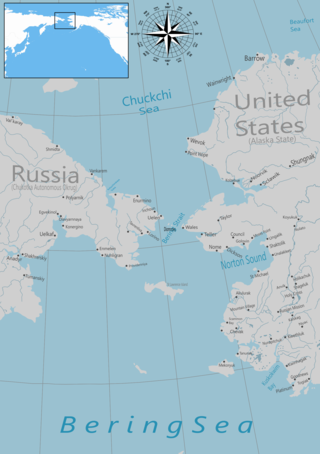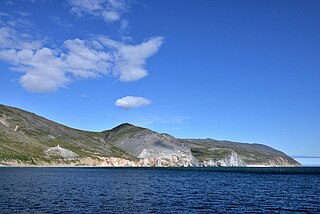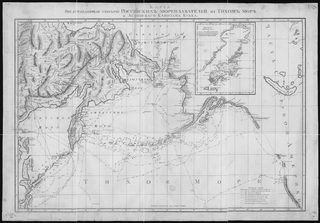
The Northwest Passage (NWP) is the sea lane between the Atlantic and Pacific oceans through the Arctic Ocean, along the northern coast of North America via waterways through the Arctic Archipelago of Canada. The eastern route along the Arctic coasts of Norway and Siberia is accordingly called the Northeast Passage (NEP). The various islands of the archipelago are separated from one another and from Mainland Canada by a series of Arctic waterways collectively known as the Northwest Passages, Northwestern Passages or the Canadian Internal Waters.

The Bering Strait is a strait between the Pacific and Arctic oceans, separating the Chukchi Peninsula of the Russian Far East from the Seward Peninsula of Alaska. The present Russia-United States maritime boundary is at 168° 58' 37" W longitude, slightly south of the Arctic Circle at about 65° 40' N latitude. The Strait is named after Vitus Bering, a Danish explorer in the service of the Russian Empire.

Vitus Jonassen Bering, also known as Ivan Ivanovich Bering, was a Danish cartographer and explorer in Russian service, and an officer in the Russian Navy. He is known as a leader of two Russian expeditions, namely the First Kamchatka Expedition and the Great Northern Expedition, exploring the north-eastern coast of the Asian continent and from there the western coast on the North American continent. The Bering Strait, the Bering Sea, Bering Island, the Bering Glacier, and Vitus Lake were all named in his honor.

Cape Dezhnyov or Cape Dezhnev ;, formerly known as East Cape or Cape Vostochny, is a cape that forms the easternmost mainland point of Asia. It is located on the Chukchi Peninsula in the very sparsely populated Chukotka Autonomous Okrug of Russia. This cape is located between the Chukchi Sea and the Bering Strait, 82 kilometres (51 mi) across from Cape Prince of Wales in Alaska; the Bering Strait is delimited by the two capes. The Diomede Islands and Fairway Rock are located in the midst of the strait.

Otto von Kotzebue was a Russian naval officer in the Imperial Russian Navy. He commanded two naval expeditions into the Pacific for the purposes of exploration and scientific investigation. The first expedition explored Oceania and the western coast of North America, and passed through the Bering Strait in search of a passage across the Arctic Ocean. His second voyage was intended as a military resupply mission to Kamchatka but again included significant explorations of the west coast of North America and Oceania.

Nils Adolf Erik Nordenskiöld was a Finland-Swedish aristocrat, geologist, mineralogist and Arctic explorer. He was a member of the Fenno-Swedish Nordenskiöld family of scientists and held the title of a friherre (baron). His ethnicity was Finnish-Swedish.

The Northeast Passage is the shipping route between the Atlantic and Pacific Oceans, along the Arctic coasts of Norway and Russia. The western route through the islands of Canada is accordingly called the Northwest Passage (NWP).

Ivan Fyodorov was a Russian navigator and commanding officer of the expedition to northern Alaska in 1732.
Semyon Ivanovich Dezhnyov was a Russian explorer of Siberia and the first European to sail through the Bering Strait, 80 years before Vitus Bering did. In 1648 he sailed from the Kolyma River on the Arctic Ocean to the Anadyr River on the Pacific. His exploit was forgotten for almost a hundred years and Bering is usually given credit for discovering the strait that bears his name.

The Chukchi Sea, sometimes referred to as the Chuuk Sea, Chukotsk Sea or the Sea of Chukotsk, is a marginal sea of the Arctic Ocean. It is bounded on the west by the Long Strait, off Wrangel Island, and in the east by Point Barrow, Alaska, beyond which lies the Beaufort Sea. The Bering Strait forms its southernmost limit and connects it to the Bering Sea and the Pacific Ocean. The principal port on the Chukchi Sea is Uelen in Russia. The International Date Line crosses the Chukchi Sea from northwest to southeast. It is displaced eastwards to avoid Wrangel Island as well as the Chukotka Autonomous Okrug on the Russian mainland.

Cape Prince of Wales is the westernmost mainland point of the Americas. It was named in 1778 by Captain James Cook of the British Royal Navy, presumably for the Prince of Wales at the time, George Augustus Frederick. Discovered in 1732, by an expedition led by a Russian military geodesist Mikhail Gvozdev in Sviatoi Gavriil ; later, the cape was named by Vitus Bering for Gvozdev as Mys Gvozdeva. The Yupik name of the cape, published by Gavril Sarychev in 1826, was Nykhta. The current name was approved by a decision of the U.S. Board on Geographic Names in 1944.

Aleksei Ilyich Chirikov was a Russian navigator and captain who, along with Vitus Bering, was the first Russian to reach the northwest coast of North America. He discovered and charted some of the Aleutian Islands while he was deputy to Vitus Bering during the Great Northern Expedition.
Dmitry Yakovlevich Laptev was a Russian Arctic explorer and Vice Admiral (1762). The Dmitry Laptev Strait is named in his honor and the Laptev Sea is named in honor of him and his cousin, and fellow Arctic explorer, Khariton Laptev.

Dmitry Leontiyevich Ovtsyn was a Russian hydrographer and Arctic explorer. The Ovtsyn family is one of the oldest Russian noble families, originating from the descendants of Rurik, the Murom princes.

Admiral Sir Richard Collinson was an English naval officer and explorer of the Northwest Passage.

Vladimir Ivanovich Voronin was a Soviet Navy captain, born in Sumsky Posad, in the present Republic of Karelia, Russia. In 1932 he commanded the expedition of the Soviet icebreaker A. Sibiryakov which made the first successful crossing of the Northern Sea Route in a single navigation without wintering. This voyage was organized by the All-Union Arctic Institute.

The Great Northern Expedition or Second Kamchatka Expedition was one of the largest exploration enterprises in history, mapping most of the Arctic coast of Siberia and some parts of the North American coastline, greatly reducing "white areas" on maps. It was conceived by Russian Emperor Peter the Great, but implemented by Russian Empresses Anna and Elizabeth. The main organiser and leader of the expedition was Vitus Bering, who earlier had been commissioned by Peter I to lead the First Kamchatka Expedition. The Second Kamchatka Expedition lasted roughly from 1733 to 1743 and later was called the Great Northern Expedition due to the immense scale of its achievements.

Mikhail Spiridonovich Gvozdev was a Russian military geodesist and a commander of the expedition to northern Alaska in 1732, when the Alaskan shore was sighted by Russians for the first time.

The VegaExpedition of 1878–1880, named after the SS Vega and under the leadership of Swedish Finnish explorer Adolf Erik Nordenskiöld, was the first Arctic expedition to navigate through the Northeast Passage, the sea route between Europe and Asia through the Arctic Ocean, and the first voyage to circumnavigate Eurasia. Initially a troubled enterprise, the successful expedition is considered to be among the highest achievements in the history of Swedish science.

The First Kamchatka Expedition was the first Russian expedition to explore the Asian Pacific coast. It was commissioned by Peter the Great in 1724 and was led by Vitus Bering. Afield from 1725 to 1731, it was Russia's first naval scientific expedition. It confirmed the presence of a strait between Asia and America and was followed in 1732 by the Second Kamchatka Expedition.


















